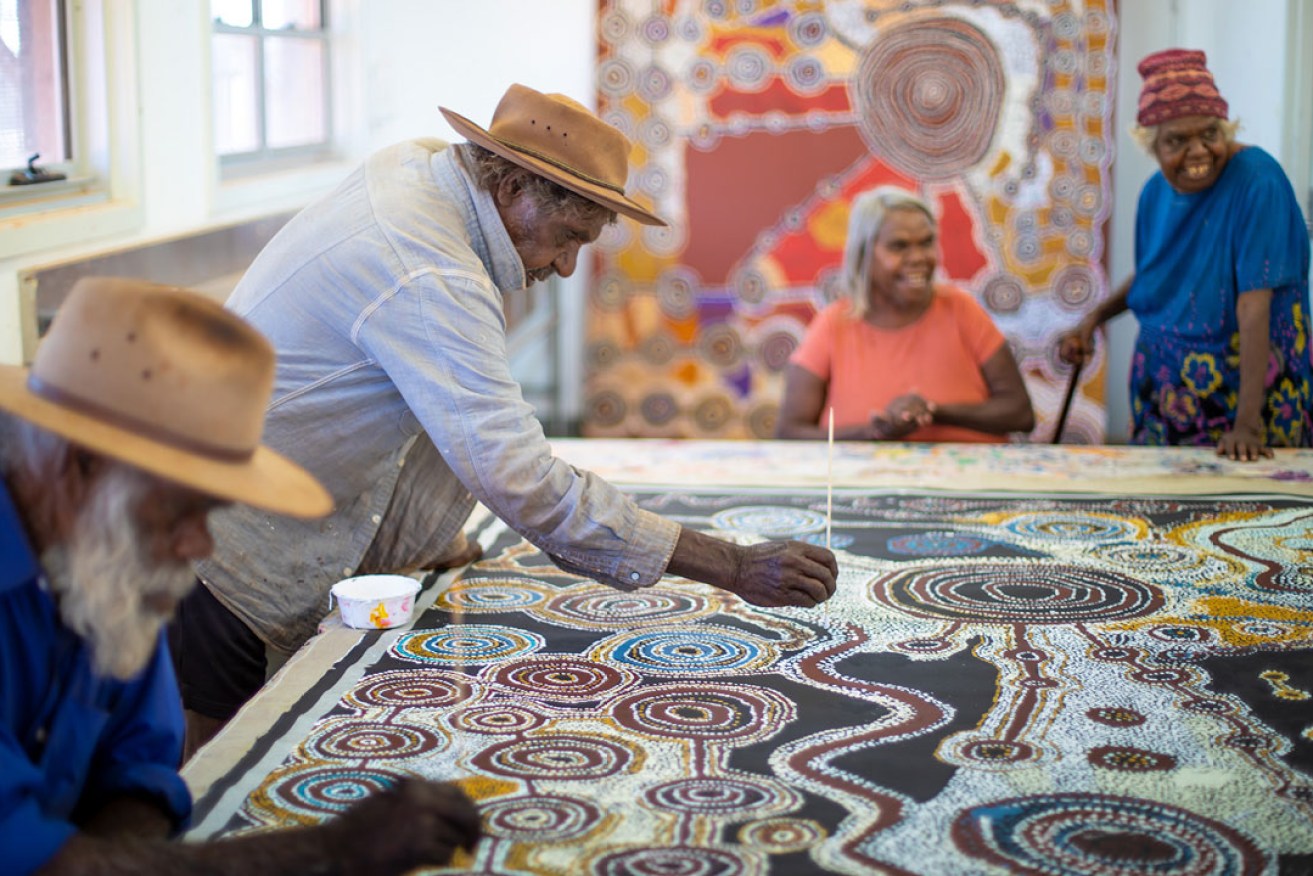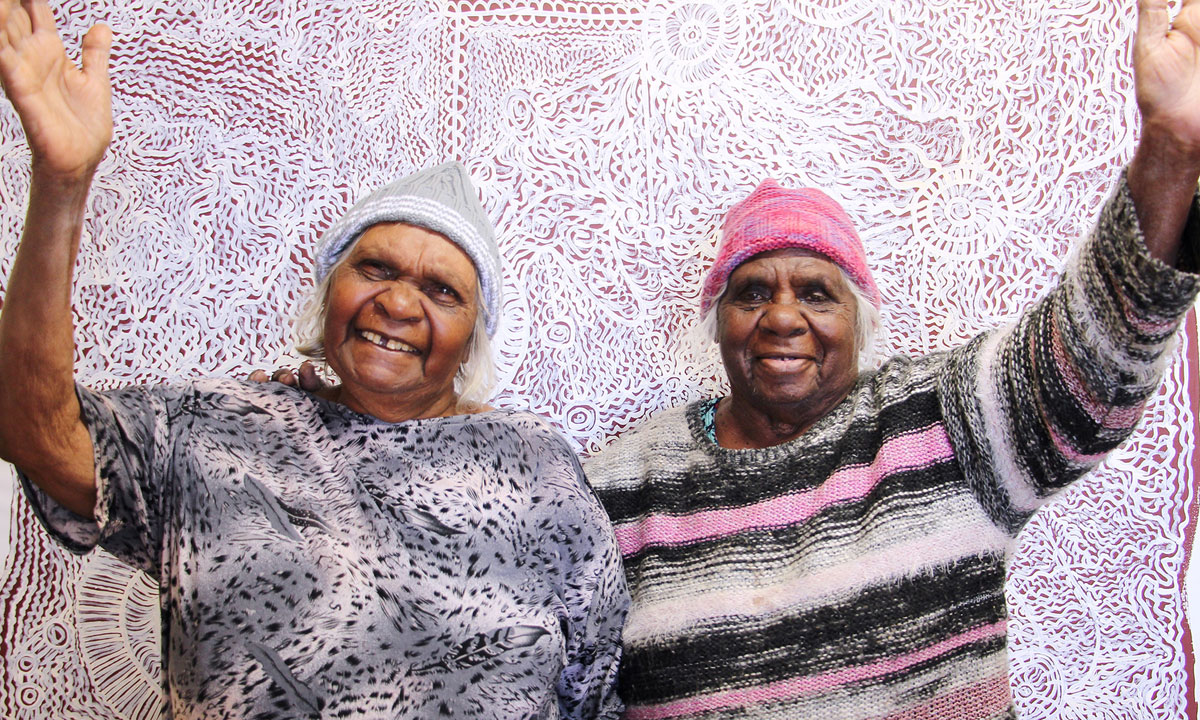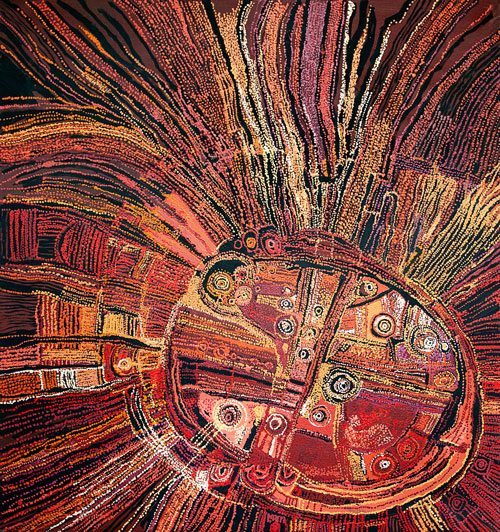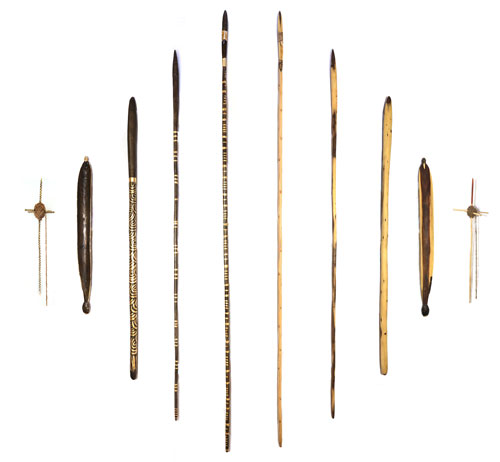Brittany spears: Art from the APY Lands heads to France
In a year of disruptions, 34 artists from the APY Lands have grasped the opportunity to shine on an international stage with works that tell the story of a new movement in Australian art history, writes Art Gallery of SA assistant director Lisa Slade.

Taylor Cooper and Witjiti George working on a collaborative painting under the watchful eye of Matjangka Norris and Tjangali George; courtesy the artists and Kaltjiti Arts. Photo: Meg Hansen
When the president of the regional Council of Brittany, Loïg Chesnais-Girard, travelled to Adelaide last year, hosted by Premier Steven Marshall, he visited the Art Gallery of South Australia.
Stepping from North Terrace into the gallery’s vestibule, the first work of art that he encountered was a monumental three-panelled painting called Kangkura-KangkuraKu Tjukurpa (A Sister’s Story), by the five Ken sisters and their mother, Paniny Mick. It is pure pyrotechnics in paint.
The dynamic energy of the painting, created in the Aṉangu Pitjantjatjara Yankunytjatjara (APY) Lands, had an immediate effect. The president experienced something for the very first time – contemporary Aboriginal art from South Australia, the newest art from the world’s oldest living culture.
The notion of a touring exhibition was born in that very moment, and with it, the commitment that art from the APY Lands and Tarnanthi, AGSA’s flagship celebration of Aboriginal and Torres Strait Islander Art, would have an international presence in Brittany.
More than a year on and the Kulata Tjuta exhibition opens at the Museum of Fine Arts in Rennes tomorrow.
At a time when even local and national exhibition programs have been seriously interrupted, the staging of this international exhibition is a true testimony to Aṉangu adaptiveness and creative genius.

Maringka Burton and Betty Muffler in front of a collaborative work-in-progress. Photo courtesy the artist and Iwantja Arts
Thirty-four artists are represented in an exhibition named after an ongoing cultural maintenance initiative that involves Aṉangu elders teaching young men to make spears – Kulata Tjuta.
Although an installation work of the same name, comprising 550 spears, was to have been the centrepiece of the exhibition, COVID-19 altered the gallery’s plans and a new, primarily painting-focused exhibition was developed.
The artists and the APY Art Centre Collective grasped this opportunity in a year of disruptions and cancellations to shine on an international stage. The resulting exhibition is a gesture of cultural diplomacy between the sister regions of Brittany and South Australia.
Several of the paintings have been made at the APY Art Centre Collective in Adelaide by the next generation of star painters, including Nyunmiti Burton, who was recently awarded the Roberts Family Prize as part of the Wynne Prize at the Art Gallery of New South Wales.

Nyunmiti Burton’s Seven Sisters, 2020. Photo courtesy APY Adelaide Studio
The beauty of the works of art on view can veil their cultural and political power. Together, these works tell the story of a new movement in Australian art history and the importance of art centres in generating cultural and economic outcomes.
As Burton states:
“Today almost all men and women who live in APY communities are involved in their art centre. Men’s and women’s cultures are joyfully celebrated and carefully instructed in art centre studios all over the APY Lands. The art centres all started small, but with the hard work and commitment of Aṉangu, they grew strong and are still growing today.
We are proud that there are so many innovative, brave and committed artists working on the APY Lands … We hope this exhibition will be the beginning of a long friendship between Brittany and the APY region. We dedicate this exhibition to the women leaders who started the APY art movement and the leaders who followed. This is their story.”
In the company of the numerous vivid paintings are a suite of photographs by artist Robert Fielding and his wall installation of weapons and tools, including kulata (spears) and miru (spear-throwers) in both timber and bronze.

Robert Fielding’s Our roots, 2020, bronze cast kulata, winta, wana, miru and inti, gold-leaf; Kulata, winta, wana, miru and inti made from mulga, kulata (spearwood), malu pulyku (kangaroo tendon) and camel wool. Photo courtesy Mimili Maku Arts
In the exhibition’s accompanying 200-page book, written in French, Breton, English and Pitjantjatjara languages, Fielding explains:
The miru (spear-thrower) gives direction to the strengths of the kuḻaṯa (spear). There is no power without direction. These objects help keep culture strong and allow the story, song and dance to be passed from one generation to the next, helping the young people along in life, holding our stories.
As Kulata Tjuta opens in Brittany, here in Adelaide the fifth Tarnanthi exhibition, titled Open Hands, opens at the Art Gallery of South Australia. All are welcome to attend the virtual launch on the gallery’s website at 6pm today, October 15.
Dr Lisa Slade is assistant director of the Art Gallery of South Australia.




